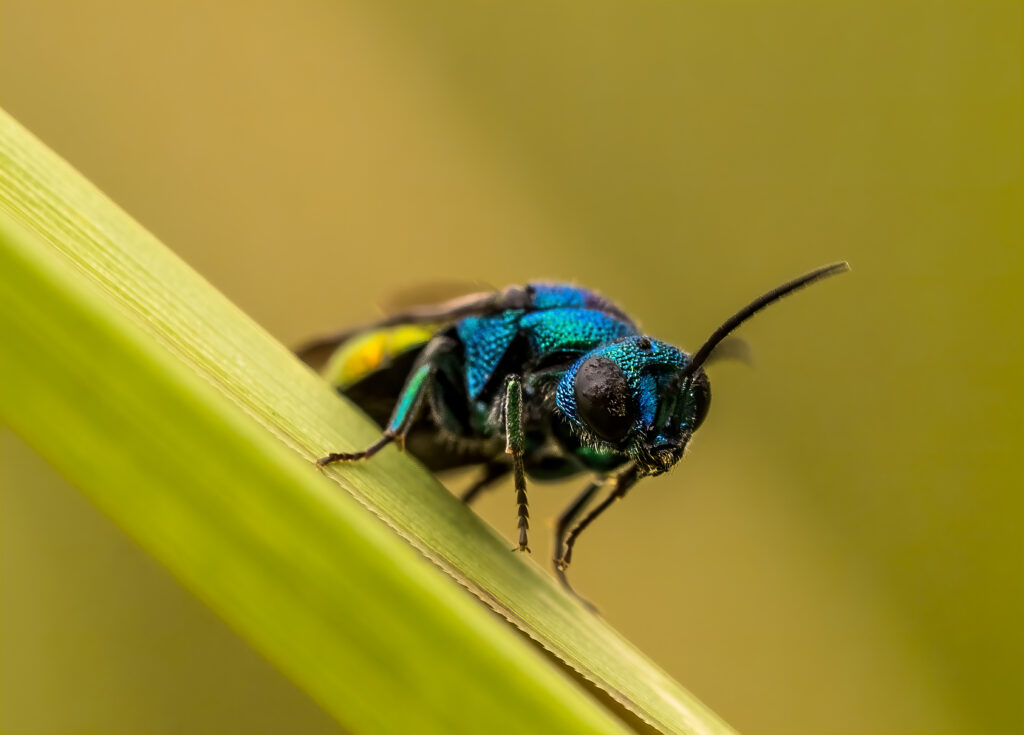Introduction
The Carpenter Bee Xylocopa is a large, robust bee known for its powerful mandibles and ability to tunnel into wood to create nests. Despite their reputation as “wood borers,” these bees are vital pollinators and play a key role in maintaining garden and wild plant biodiversity.
1. Classification and Habitat
- Belongs to the genus Xylocopa in the family Apidae.
- Found worldwide, especially in tropical and subtropical regions, but common in North America, Asia, and parts of Europe.
- Prefers dead trees, bamboo, wooden structures, or even untreated timber to excavate nesting galleries.
2. Distinctive Appearance
- Size: Typically 12–25 mm long—larger than most honeybees.
- Colour: Often metallic blue, green, or black with a shiny, hairless abdomen.
- Difference from Bumblebees: Carpenter bees have smooth, glossy abdomens, while bumblebees appear fuzzy.
3. Unique Behaviour and Nesting Habits
- Wood Tunnelling: Females drill near-perfect round entry holes (about ½ inch wide) into dead wood or soft lumber.
- Solitary Lifestyle: Unlike honeybees, Carpenter Bee Xylocopa females live and nest alone or in small loose groups.
- Pollen Provisioning: Females create a series of chambers stocked with pollen and nectar, then lay a single egg in each.
4. Pollination Power
- Buzz Pollination: Carpenter bees use powerful vibrations to release pollen from flowers, aiding crops like tomatoes, eggplants, and blueberries.
- Night Activity in Some Species: Certain tropical species pollinate night-blooming plants, ensuring continuous ecosystem support.
- Species Diversity
| Species | Region | Key Feature |
| Xylocopa virginica | Eastern North America | Common around houses and gardens; known for wood tunnelling in decks and fences. |
| Xylocopa violacea | Europe & Asia | Striking violet-black colour; nests in dead tree trunks. |
| Xylocopa tenuiscapa | South Asia | Large species with a shiny metallic sheen, active even at dusk. |
6. Carpenter Bees and Human Spaces
- While Carpenter Bee Xylocopa females can weaken wooden structures over many years, they rarely cause serious damage.
- Males cannot sting; females sting only when provoked.
- To deter nesting, paint or treat wood surfaces and seal cracks—without using harmful pesticides.
7. Conservation Importance
- Crucial pollinators for many wildflowers and crops.
- Sensitive to habitat loss, pesticide use, and removal of dead wood, which limits nesting sites.
- Supporting them by planting native flowering plants and leaving some dead wood or bamboo stems can help maintain healthy populations.
FAQs:
Q1: Do carpenter bees damage houses?
They can tunnel into untreated or unpainted wood, but significant structural damage is rare.
Q2: Can carpenter bees sting?
Females can sting if handled roughly; males cannot sting at all.
Q3: How are carpenter bees different from bumblebees?
Carpenter bees have smooth, shiny abdomens and nest in wood, while bumblebees have fuzzy abdomens and nest in soil.
Q4: Are carpenter bees good pollinators?
Yes. Their buzz pollination helps fruiting in crops like tomatoes and berries.
Q5: How to deter carpenter bees naturally?
Paint or seal exposed wood, use hardwoods for construction, and provide alternative nesting materials like bamboo stems.
Conclusion:
The Carpenter Bee (Xylocopa) is both an expert carpenter and an invaluable pollinator. While they occasionally nest in human structures, they are essential to ecosystems and agriculture. Protecting their habitats and using bee-friendly management ensures these powerful wood-carving pollinators continue to thrive.







